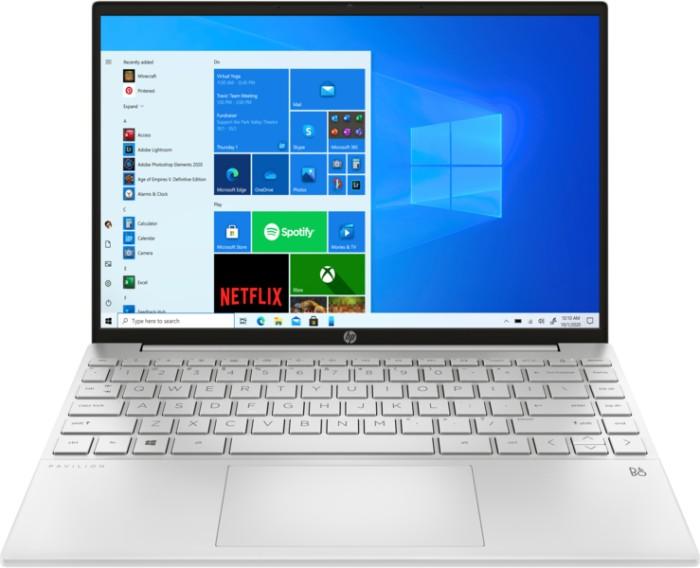
Share to Facebook
Share to Twitter
Share to Linkedin
HP Pavilion Aero 13.
Credit: Hewlett-Packard
The HP Pavilion Aero 13 manifests an emerging trend of sub-2.5-pound laptops with zip.
tl;dr: The just-released HP Pavilion Aero 13 is only 2.2 pounds but delivers good performance that rivals or exceeds larger laptops with the Intel Core i7-1185G7, a popular CPU for thin and light laptops.
This is a brief first-take review focused on performance.
Pros:
Extremely lightweight (full magnesium aluminum chassis)
Good performance for ultra-light laptop
Minimal chassis heat
16:10 display aspect with 10% more vertical viewing than traditional 16:9
Cons:
Speakers OK but not up to HP Spectre or EliteBook standards
Keyboard good enough but not as good as higher-end HP laptops
No Face ID (fingerprint reader only)
Performance: energy-efficient processor with pep
In my real-world* testing (see bottom notes), the HP Pavilion Aero 13 delivers performance that’s on par with or exceeds the widely-used Intel Core i7-1185G7, a processor typically used in bulkier laptops (e.g., over 2.6 pounds).
Synthetic benchmarks back this up. While single-core Cinebench R23 and Geekbench 5 are shy of the Core i7-1185G7,
multicore handily beats the Intel CPU
(via CPU Monkey as reference).
MORE FOR YOU
Apple’s Surprise iPhone 13 Upgrade Suddenly Revealed
Forget The MacBook Pro, Apple Has Bigger Plans
Serious Warning Issued For Millions Of Apple iPhone Users
See these results:
AMD Ryzen 7 5800U
(HP Pavilion Aero 13) vs
Core i7-1185G7
(Dell XPS 13 9310 et al).
It’s too early to say anything definitive about battery life. But I will say that after using it on battery over the course of two days, it goes a full working day (intermittent use throughout the day) without a recharge based on my usage scenarios*.
Design

It’s not easy to go back to a 2.8 or 3-pound laptop after you carry around the Pavilion Aero 13 and similar laptops like the Thinkpad X1 Nano (2 pounds).
I can’t overstate how important laptop weight is for road warriors. When I’m constantly pulling a laptop out of my bag, putting it back, then pulling it out again...if that’s done dozens — or more — times over the course of the day, you appreciate a laptop that weighs only 2.2 pounds.
What a 2-pound 12-inch MacBook could be
The Pavilion Aero 13 is in the same class of portability as the 2-pound 12-inch Retina MacBook (now discontinued). That laptop (I owned several iterations) was wonderfully light but slow and had lousy battery life to boot.
Imagine how fast a 12-inch MacBook could be today with an Apple M series processor? And imagine the battery life too! Today Apple could pull off a great 2-pound design with ease.
Ports: 1 USB-C
—HDMI (1)
—USB Type-A (2)
—USB Type-C (1)
Keyboard: no major complaints
You’re not getting the stellar keyboards on the HP EliteBook series but the
key travel
is good enough and useable for long stretches of typing.
Display: good (for this category of laptop)
The Pavilion Aero’s WUXGA (1,920-by-1,200) delivers higher resolution than the standard FHD (1,920-by-1,080) and the anti-glare is easy on the eyes.
Bright, high-resolution displays are a huge battery drain and a challenge for sub-2.5-pound laptops with smaller battery capacities. But HP has struck a happy medium: an above-average display and good battery life.
Specs: my HP Pavilion Aero 13
Processor / graphics: AMD Ryzen 7 5800U (up to 4.4 GHz, 16 MB L3 cache, 8 cores, 16 threads) + AMD Radeon Graphics
Display: 13.3" diagonal, WUXGA (1,920-by-1,200), IPS, micro-edge, anti-glare, 400 nits, 16:10 aspect ratio
Memory: 16 GB DDR4-3200 MHz RAM
Storage: 512 GB PCIe NVMe M.2 SSD (Intel)
Battery: 43 Wh Li-ion polymer
Biometrics: fingerprint reader
Camera: 720p HD
Weight: 2.2 pounds
Material: aluminum/magnesium
WiFi / Bluetooth: WiFi 6, Bluetooth 5.2
Ports: 2 x USB-A, 1 x USB-C
Price: as shown above $989.99
——
NOTES:
*For me, “real world” is based on my usage scenario which includes running Google Chrome with 20+ tabs (the single biggest power drain), Firefox browser, Microsoft Office, Google Docs, social media, YouTube videos (in background playing music), CMS, video conferencing (e.g., Zoom, Microsoft Teams), Apple Music, benchmarking applications, and photo editing. Display brightness is typically set at over 70 percent. Laptop is run until it loses power.
HP Pavilion Aero 13.
Credit: Brooke Crothers
